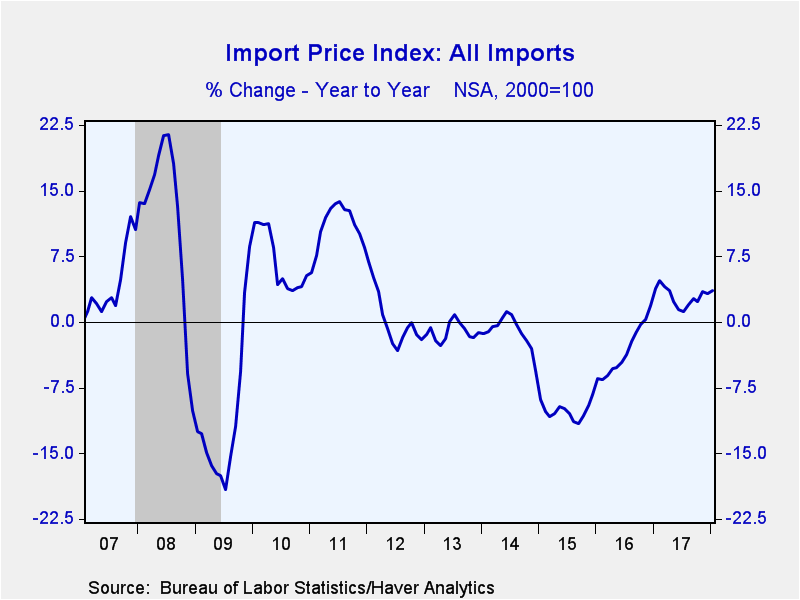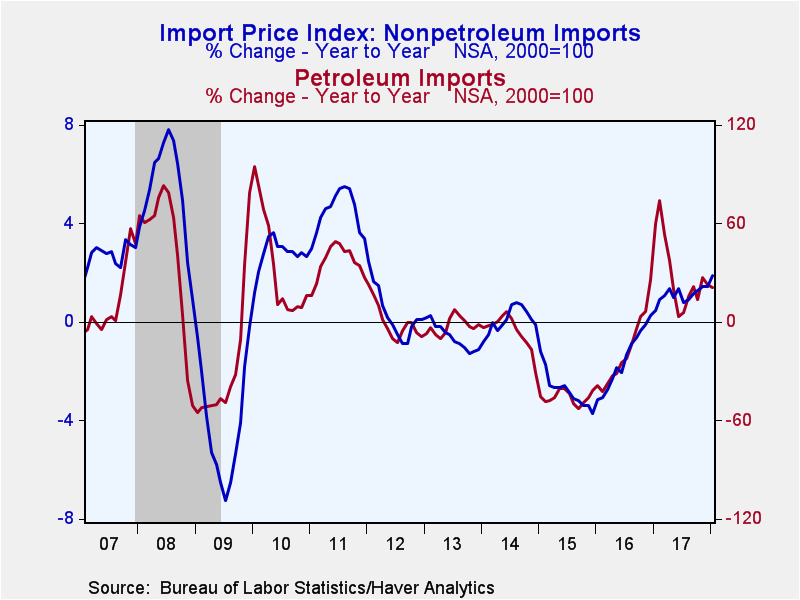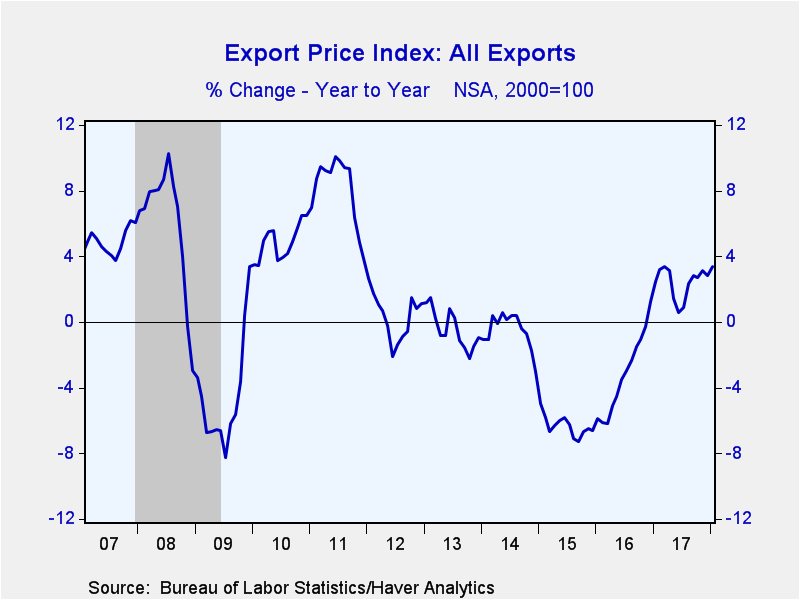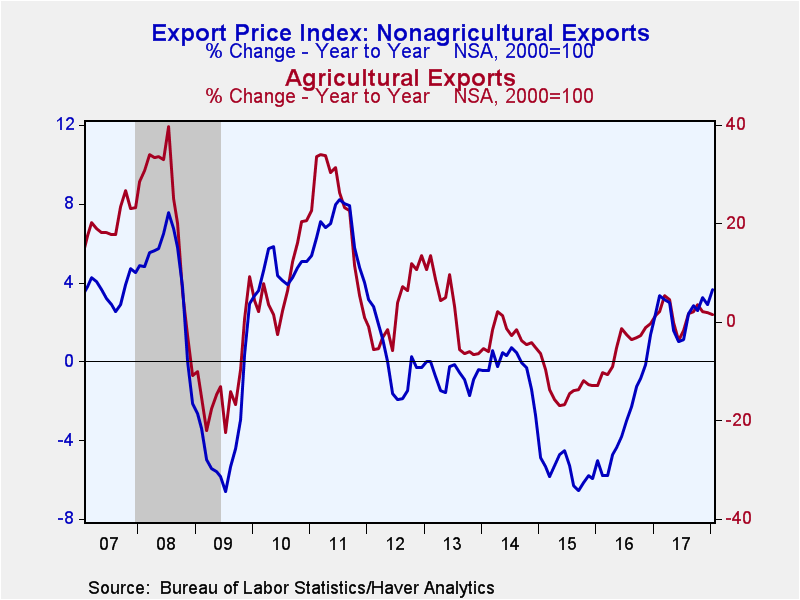 Global| Feb 16 2018
Global| Feb 16 2018U.S. Import & Export Prices Strengthen Broadly
by:Tom Moeller
|in:Economy in Brief
Summary
Import prices increased 1.0% during January (3.6% y/y) for the second time in three months. A 0.6% rise had been expected in the Action Economics Forecast Survey. These figures are not seasonally adjusted. Petroleum import prices [...]
Import prices increased 1.0% during January (3.6% y/y) for the second time in three months. A 0.6% rise had been expected in the Action Economics Forecast Survey. These figures are not seasonally adjusted.
Petroleum import prices strengthened 4.3% (20.9% y/y) following strong increases in four of the previous six months. Nonpetroleum import prices jumped 0.5% (1.9% y/y), the strongest increase since April 2011. Amongst end-use categories, industrial supplies and materials prices excluding petroleum increased 2.4% (9.1% y/y) after a 0.4% rise. Among other detail categories, prices of foods, feeds and beverages rose 0.8% (3.1% y/y) and reversed a 0.9% dip. Capital goods prices edged 0.1% higher. Year-to-year growth picked up to 0.9% following declines in each of the prior five years. Capital goods prices excluding computers, semiconductors & peripherals rose 0.3% and increased 0.7% y/y after five years of decline. Prices of motor vehicles and parts improved 0.5% (0.6% y/y) following three consecutive months of stability. Prices of consumer goods excluding automobiles held steady, and the y/y change of -0.2% continues the declining trend of the last three years.
Export prices increased 0.8%, the strongest increase since September. Annual growth of 3.4% is stronger than 2.4% last year and up from declines in 2015 & 2016. The Action Economics Survey expected a modest 0.3% rise for January.
The total export price increase was powered by a 0.9% improvement (3.7% y/y) in nonagricultural export prices, the strongest gain since September. Agricultural export prices eased 0.1% (+1.4% y/y) following declines in three of the prior four months. Among the end-use categories for exports, overall foods, feeds and beverage prices fell 0.2% (+1.5% y/y), down in four of the last five months. Prices of industrial supplies and materials increased 2.0% (7.6% y/y) after a 0.6% rise, as petroleum prices gained 3.2% (16.2 y/y. Nonagricultural supplies and materials prices excluding fuels and building materials increased 1.1% (5.4% y/y) after a 0.2% gain. Prices of motor vehicles and parts rose 0.3% (0.4% y/y) following two months of slight decline. Capital goods prices strengthened 0.5% (2.0% y/y), the strongest gain in three months. Capital goods prices excluding computers, peripherals & semiconductors rose 0.5% (1.9% y/y). Auto export prices rose 0.3% (0.4% y/y) after a 0.2% rise last year. Non-auto consumer goods prices rose 0.3% (1.9% y/y), the strongest gain in five months.
The import and export price series can be found in Haver's USECON database. Detailed figures are available in the USINT database. The expectations figure from the Action Economics Forecast Survey is in the AS1REPNA database.
| Import/Export Prices (NSA, %) | Jan | Dec | Nov | Y/Y | 2017 | 2016 | 2015 |
|---|---|---|---|---|---|---|---|
| Imports - All Commodities | 1.0 | 0.2 | 1.0 | 3.6 | 2.9 | -3.3 | -10.2 |
| Petroleum | 4.3 | 2.3 | 9.5 | 20.9 | 26.6 | -19.7 | -46.0 |
| Nonpetroleum | 0.5 | 0.0 | 0.2 | 1.9 | 1.1 | -1.5 | -2.8 |
| Exports - All Commodities | 0.8 | 0.1 | 0.5 | 3.4 | 2.4 | -3.2 | -6.3 |
| Agricultural | -0.1 | -0.3 | -0.7 | 1.4 | 1.5 | -5.4 | -13.3 |
| Nonagricultural | 0.9 | 0.1 | 0.7 | 3.7 | 2.5 | -3.0 | -5.5 |
Tom Moeller
AuthorMore in Author Profile »Prior to joining Haver Analytics in 2000, Mr. Moeller worked as the Economist at Chancellor Capital Management from 1985 to 1999. There, he developed comprehensive economic forecasts and interpreted economic data for equity and fixed income portfolio managers. Also at Chancellor, Mr. Moeller worked as an equity analyst and was responsible for researching and rating companies in the economically sensitive automobile and housing industries for investment in Chancellor’s equity portfolio. Prior to joining Chancellor, Mr. Moeller was an Economist at Citibank from 1979 to 1984. He also analyzed pricing behavior in the metals industry for the Council on Wage and Price Stability in Washington, D.C. In 1999, Mr. Moeller received the award for most accurate forecast from the Forecasters' Club of New York. From 1990 to 1992 he was President of the New York Association for Business Economists. Mr. Moeller earned an M.B.A. in Finance from Fordham University, where he graduated in 1987. He holds a Bachelor of Arts in Economics from George Washington University.










